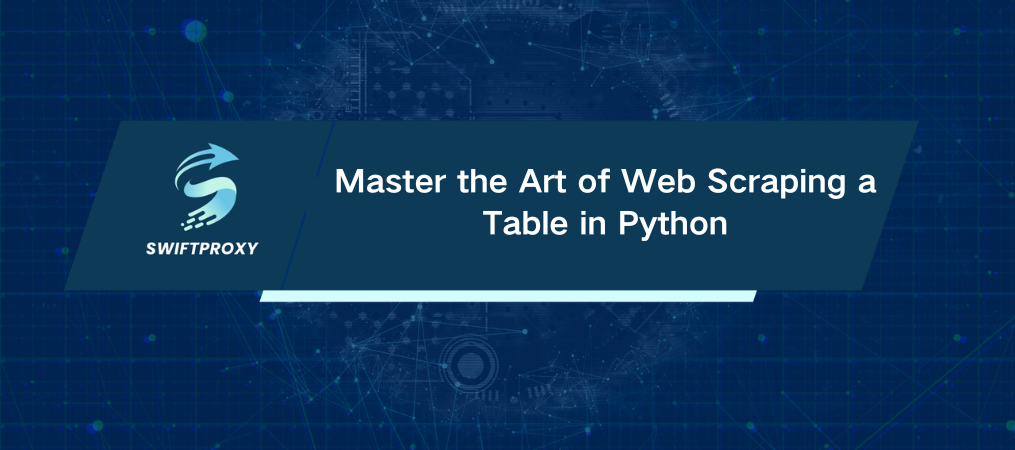Master the Art of Web Scraping a Table in Python

The internet is a goldmine of structured data—especially in tables. As a professional, you know that every dataset can hold key insights for business, research, or analysis. But manually copying data from websites? That's a time-sink. Instead, web scraping automates the process, saving you hours and reducing human error. And Python? It's the go-to tool for this task. Let's dive into how you can scrape tables with Python and make the most of this efficient method.
Why Scrape Tables
Data in tables is perfect for analysis. Whether it's competitor pricing, stock data, or market trends, these tables give you a clean, structured format ready for action. Think about the possibilities:
· Market Analysis: Track competitor prices, products, and customer reviews.
· SEO Monitoring: Extract keyword rankings, backlinks, and search results.
· Financial Analysis: Grab stock market prices and cryptocurrency stats in real time.
· E-Commerce Insights: Keep tabs on product listings and customer ratings.
Scraping isn't just about collecting data—it's about using that data to inform smarter decisions.
Preparing Your Environment
First thing's first: let's get your environment set up so you can start scraping right away. You'll need a few key Python libraries.
Install Key Libraries
You'll be using BeautifulSoup, Requests, Pandas, and Selenium. These libraries cover a range of scraping needs, from static HTML to dynamic content.
Run this in your terminal:
pip install beautifulsoup4 requests pandas selenium
Each of these libraries serves a purpose:
· BeautifulSoup is great for static HTML.
· Requests is perfect for sending HTTP requests to fetch webpage content.
· Pandas helps store data in a format you can work with.
· Selenium comes in for dynamic, JavaScript-driven tables.
Understanding Table Structure
In HTML, tables are wrapped in <table> tags, with rows defined by <tr>, and individual cells by <td>. You'll need to locate this structure in the source code to extract the data.
Here's a quick look at a basic table:
<table>
<tr><td>Item 1</td><td>$10</td></tr>
<tr><td>Item 2</td><td>$20</td></tr>
</table>
Your goal? Use Python to loop through <tr> tags, extract the data from <td>, and store it.
How to Extract Table Data
Once your environment is ready, let's jump into the different ways to extract table data. I'll walk you through three common methods:
1. Scraping with BeautifulSoup
This is the simplest method when dealing with static HTML. Here's the basic process:
from bs4 import BeautifulSoup
import requests
url = 'https://example.com/table'
response = requests.get(url)
soup = BeautifulSoup(response.content, 'html.parser')
table = soup.find('table')
rows = table.find_all('tr')
data = []
for row in rows:
cols = row.find_all('td')
data.append([col.text for col in cols])
print(data)
This grabs data from the table and stores it in a list. You can then convert it into a Pandas DataFrame for easier analysis.
2. Scraping with Pandas
Pandas shines when the table is neatly structured. If the table follows a standard format, Pandas can handle the extraction with minimal code:
import pandas as pd
url = 'https://example.com/table'
table = pd.read_html(url)[0]
print(table)
Pandas automatically finds the tables and converts them into DataFrames, saving you the trouble of manually parsing each row.
3. Scraping with Selenium for Dynamic Content
If the table is loaded dynamically by JavaScript, you'll need Selenium to render the page fully before scraping. Here's how:
from selenium import webdriver
from bs4 import BeautifulSoup
driver = webdriver.Chrome()
driver.get('https://example.com/dynamic-table')
soup = BeautifulSoup(driver.page_source, 'html.parser')
table = soup.find('table')
rows = table.find_all('tr')
data = []
for row in rows:
cols = row.find_all('td')
data.append([col.text for col in cols])
driver.quit()
Selenium opens the page like a browser, ensuring all JavaScript is executed, which is key when scraping dynamic tables.
Overcoming Scraping Challenges
Not all tables are straightforward to scrape. Websites put up barriers to prevent abuse, and you'll likely run into issues like:
· JavaScript-rendered content: As mentioned, Selenium is your go-to here.
· IP blocking and rate limiting: Sending too many requests too quickly? Your IP might get blocked. The solution: use residential proxies. These rotate IPs, so you don‘’t get caught.
· CAPTCHAs: Some sites deploy CAPTCHAs to stop scrapers. Using a service that solves these for you or simulating human behavior with Selenium can help you bypass them.
Scaling Scraping with Residential Proxies
When you're scraping at scale, your IP can quickly get flagged. That's where Swiftproxy's residential proxies come into play. They'll help you scrape efficiently without worrying about bans.
Here's why you need them:
· Rotating Proxies: Automatically change IP addresses, making you look like multiple users.
· Static Proxies: Maintain session consistency, ideal for long scraping sessions.
· Geo-targeting: Scrape location-specific data.
· 24/7 Support: Handle large-scale projects without hassle.
Using residential proxies ensures you can scale up scraping efforts without triggering alarms.
Conclusion
Python simplifies web scraping, whether you're extracting data from a static table or a dynamic one with JavaScript. If you need to web scrape a table in Python, tools like BeautifulSoup, Pandas, and Selenium are your go-to options. By using these libraries along with the proper use of proxies, you can scrape efficiently and ethically. Start extracting valuable data for your business, research, or competitive analysis.

















































